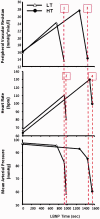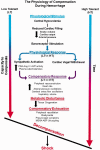The physiology of blood loss and shock: New insights from a human laboratory model of hemorrhage
- PMID: 28346013
- PMCID: PMC5407541
- DOI: 10.1177/1535370217694099
The physiology of blood loss and shock: New insights from a human laboratory model of hemorrhage
Abstract
The ability to quickly diagnose hemorrhagic shock is critical for favorable patient outcomes. Therefore, it is important to understand the time course and involvement of the various physiological mechanisms that are active during volume loss and that have the ability to stave off hemodynamic collapse. This review provides new insights about the physiology that underlies blood loss and shock in humans through the development of a simulated model of hemorrhage using lower body negative pressure. In this review, we present controlled experimental results through utilization of the lower body negative pressure human hemorrhage model that provide novel insights on the integration of physiological mechanisms critical to the compensation for volume loss. We provide data obtained from more than 250 human experiments to classify human subjects into two distinct groups: those who have a high tolerance and can compensate well for reduced central blood volume (e.g. hemorrhage) and those with low tolerance with poor capacity to compensate.We include the conceptual introduction of arterial pressure and cerebral blood flow oscillations, reflex-mediated autonomic and neuroendocrine responses, and respiration that function to protect adequate tissue oxygenation through adjustments in cardiac output and peripheral vascular resistance. Finally, unique time course data are presented that describe mechanistic events associated with the rapid onset of hemodynamic failure (i.e. decompensatory shock). Impact Statement Hemorrhage is the leading cause of death in both civilian and military trauma. The work submitted in this review is important because it advances the understanding of mechanisms that contribute to the total integrated physiological compensations for inadequate tissue oxygenation (i.e. shock) that arise from hemorrhage. Unlike an animal model, we introduce the utilization of lower body negative pressure as a noninvasive model that allows for the study of progressive reductions in central blood volume similar to those reported during actual hemorrhage in conscious humans to the onset of hemodynamic decompensation (i.e. early phase of decompensatory shock), and is repeatable in the same subject. Understanding the fundamental underlying physiology of human hemorrhage helps to test paradigms of critical care medicine, and identify and develop novel clinical practices and technologies for advanced diagnostics and therapeutics in patients with life-threatening blood loss.
Keywords: Tissue oxygenation; lower body negative pressure; resuscitation; trauma; vital signs.
Figures

 ) and LBNP (•) in baboons corresponding to 6.25% (n = 14), 12.5% (n = 14), 18.75% (n = 14) and 25% (n = 12) total blood volume loss. Human responses to six levels of LBNP are superimposed (
) and LBNP (•) in baboons corresponding to 6.25% (n = 14), 12.5% (n = 14), 18.75% (n = 14) and 25% (n = 12) total blood volume loss. Human responses to six levels of LBNP are superimposed ( ). Data are expressed as mean ± SD. Modified from Convertino et al. and Hinojosa-Laborde et al.
). Data are expressed as mean ± SD. Modified from Convertino et al. and Hinojosa-Laborde et al.








Similar articles
-
Use of advanced machine-learning techniques for noninvasive monitoring of hemorrhage.J Trauma. 2011 Jul;71(1 Suppl):S25-32. doi: 10.1097/TA.0b013e3182211601. J Trauma. 2011. PMID: 21795890 Review.
-
Physiological and medical monitoring for en route care of combat casualties.J Trauma. 2008 Apr;64(4 Suppl):S342-53. doi: 10.1097/TA.0b013e31816c82f4. J Trauma. 2008. PMID: 18385586 Review.
-
Predictors of the Onset of Hemodynamic Decompensation During Progressive Central Hypovolemia: Comparison of the Peripheral Perfusion Index, Pulse Pressure Variability, and Compensatory Reserve Index.Shock. 2015 Dec;44(6):548-53. doi: 10.1097/SHK.0000000000000480. Shock. 2015. PMID: 26529655
-
The Compensatory Reserve For Early and Accurate Prediction Of Hemodynamic Compromise: A Review of the Underlying Physiology.Shock. 2016 Jun;45(6):580-90. doi: 10.1097/SHK.0000000000000559. Shock. 2016. PMID: 26950588 Review.
-
Estimation of individual-specific progression to impending cardiovascular instability using arterial waveforms.J Appl Physiol (1985). 2013 Oct 15;115(8):1196-202. doi: 10.1152/japplphysiol.00668.2013. Epub 2013 Aug 8. J Appl Physiol (1985). 2013. PMID: 23928113
Cited by
-
The AccuFlow sensor: a novel digital health tool to assess intrapartum blood loss at cesarean delivery.J Perinat Med. 2023 May 9;51(8):997-1005. doi: 10.1515/jpm-2023-0101. Print 2023 Oct 26. J Perinat Med. 2023. PMID: 37155696 Free PMC article.
-
CBF oscillations induced by trigeminal nerve stimulation protect the pericontusional penumbra in traumatic brain injury complicated by hemorrhagic shock.Sci Rep. 2021 Oct 4;11(1):19652. doi: 10.1038/s41598-021-99234-8. Sci Rep. 2021. PMID: 34608241 Free PMC article.
-
Non-invasive biomarkers for detecting progression toward hypovolemic cardiovascular instability in a lower body negative pressure model.Sci Rep. 2024 Apr 15;14(1):8719. doi: 10.1038/s41598-024-59139-8. Sci Rep. 2024. PMID: 38622207 Free PMC article.
-
Detecting central hypovolemia in simulated hypovolemic shock by automated feature extraction with principal component analysis.Physiol Rep. 2018 Nov;6(22):e13895. doi: 10.14814/phy2.13895. Physiol Rep. 2018. PMID: 30488597 Free PMC article.
-
Neuromodulation as a new avenue for resuscitation in hemorrhagic shock.Bioelectron Med. 2019 Oct 24;5:17. doi: 10.1186/s42234-019-0033-z. eCollection 2019. Bioelectron Med. 2019. PMID: 32232106 Free PMC article. Review.
References
-
- Burgess FW, Sborov MJ, Calcagni DR. Hemorrhage, shock, and fluid resuscitation. In: Zajtchuk R, Bellamy RF (eds) Anesthesia and perioperative care of the combat casualty. Washington, DC: Office of The Surgeon General at TMM Publications, 1995, pp. 95–7.
-
- Wilson RF (ed.). Handbook of trauma: pitfalls and pearls. Philadelphia, PA: Lippincott Williams & Wilkins, 1999.
-
- Soller BR, Sliwa J, Yang Y, Zou F, Ryan KL, Rickards CA, Convertinob VA. Simultaneous spectroscopic determination of forearm muscle pH and oxygen saturation during simulated haemorrhage. Mortality 2012; 3: 4–4.
-
- Howard JT, Janak JC, Hinojosa-Laborde C, Convertino VA. Specificity of compensatory reserve and tissue oxygenation as early predictors of tolerance to progressive reductions in central blood volume. Shock 2016; 46: 68–73. - PubMed
Publication types
MeSH terms
Substances
LinkOut - more resources
Full Text Sources
Other Literature Sources
Medical

